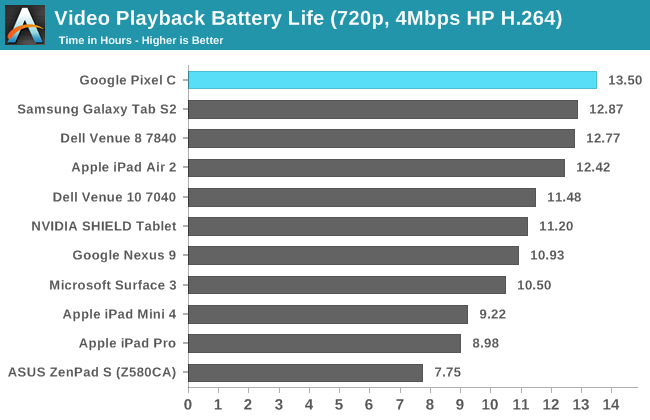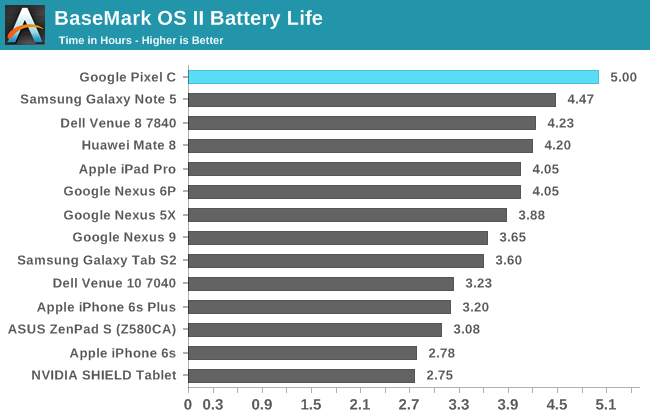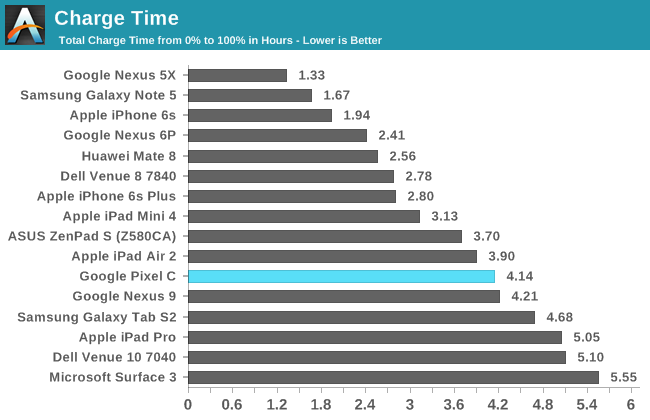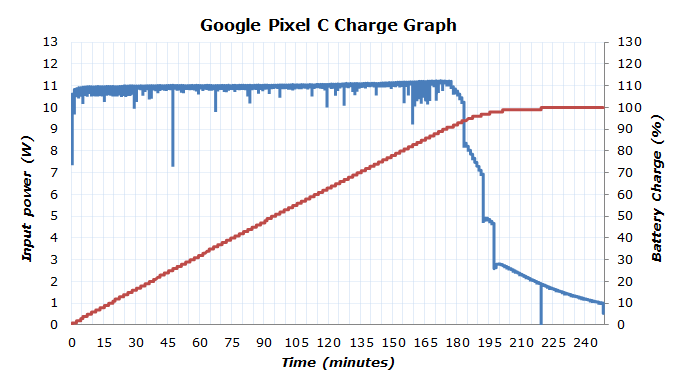The Google Pixel C Review
by Brandon Chester & Joshua Ho on January 25, 2016 8:00 AM ESTBattery Life
When Apple unveiled the iPad, they promised that it would achieve 10 hour battery life. That has been something of a standard for tablets now, and for the most part we've seen that high end tablets end up meeting that goal, while mid range ones often end up falling short of it. 2015 was a bit of an exception to this in some ways, with many high end tablets also missing this goal by several hours in some cases. Due to the nature of tablets and how they're used, it's really difficult to recommend one if it doesn't achieve enough battery life to last you through the day with a normal workload.
To test the Pixel C's battery life I've attempted to run it through all of our battery tests. First up is our internal web browser test, followed by our video playback battery test.

It's clear that Google's use of a LTPS display and a large battery pay off big time when you look at battery life. Even with the SoC staying on its higher-power A57 cores, the Pixel C manages to last for over 13 hours in our web browsing test. This puts it ahead of every other tablet on record, and by a large margin too.

In video playback the Pixel C once again comes out on top. This is quite surprising, as normally AMOLED tablets perform best in this test due to their ability to turn off pixels when displaying black, as well as their general efficiencies with darker colors and shades. The gap between the Pixel C and the Tab S2 isn't insignificant either, so Google should be very happy with what they've achieved here.

In BaseMark OS II's CPU-bound battery test we again see the Pixel C top the charts. This is really surprising to me, because on the SoC side we're looking at four Cortex A57 cores on a 20nm process. Again, Google's large battery and LTPS display help a great deal, but it's also clear that Tegra X1 isn't causing any significant problems for the Pixel C as far as power consumption goes.
At this point I would normally continue to run our PCMark and GFXBench battery tests. Unfortunately, the Pixel C's software makes it incapable of completing either of them. I made five attempts to complete PCMark, which took a great deal of time as the test runs over many hours. In all cases the tablet locked up during the test and required a hard reboot. It may be possible to eventually get it to complete, but I didn't feel that it was worth delaying the review further in the hopes that I could eventually get the Pixel C to complete the test properly.
As for GFXBench, it instantly stops due to it detecting that the tablet is plugged in. I believe this may relate to Google's system for inductive keyboard charging, but whatever the cause may be the result is that I can't get a battery result for GPU-bound workloads either. It's worth noting that the web test also required several runs before I could get it to complete the test without the tablet crashing, so that's something to think about as far as software stability and reliability goes.
In the end, what I have seen of the Pixel C's battery life leads me to believe that it's quite good, but we're definitely not looking at the entire picture here due to the missing data. I can say that in my experience it seemed to last a long time, so if I had to go out on a limb I would say that the combination of the low power LTPS display panel and a relatively large battery allow for very good battery life even with the CPU running on its A57 cores. Since Tegra X1 has a great deal of GPU power I really wish I could have gotten a GFXBench battery result, but there's not much that can be done there.
Charging
Since tablets usually offer enough battery life to get through the day, being able to charge them incredibly quickly becomes less of a need than with smartphones because you'll often end up only charging your tablet overnight. That being said, the immense charge time required by older tablets which required larger batteries to power their SoCs and displays meant that if your tablet battery did die you probably weren't going to get to use it until the next day. With modern tablets we've seen a push to reduce battery capacity, as well as the inclusion of 10-15W chargers to reduce charge times.

The Pixel C ships with a 15W charger with a USB Type-C connector. The cable is actually fixed to the block, so you can't use it as a normal Type-C to Type-C cable. On the bright side, Google has used a cable which is around four feet long, so you get some extra length compared to using the included cable in the box. As you can see in the graph above, the battery is charged at around 11W while fast charging, which lasts for three hours before trickle charging begins. Getting the remaining 10-15% ends up taking another hour, with the total charge time from 0% to 100% being 4.14 hours. Considering that the Pixel C packs a noticeably larger battery than the iPad Air 2, the roughly four hour charge time is actually quite a good result.











122 Comments
View All Comments
xthetenth - Monday, January 25, 2016 - link
I actually use the home screen a good bit on my phone but that's because I have a windows phone and it's actually useful. On tablets I'm more likely to use a broader and more varied set of apps and use the task switcher and apps list.Alexstarfire - Tuesday, January 26, 2016 - link
I use the home screen on my phone for just about everything really. I don't own a tablet but I can only imagine I'd do the same thing on it. I've got everything laid out on my home screen with folder(s) for grouping when necessary. Only time I go into the app drawer is to go to the gallery and to settings, and that's because I'm lazy and don't use them a whole lot. Task Switcher/Manager is used if I know the app I'm looking for was only used a couple apps ago. I'm not going to go scrolling through all my apps when it's easier to just go to the home screen and click the icon.Given that it's called the "Home Screen" I think you're not using your device to its potential if you are on your home screen so infrequently. To each his own though. :)
lilmoe - Monday, January 25, 2016 - link
This is a good iPad Pro competitor. But both aren't Surface competitors. Stop spreading stupidity.SaolDan - Monday, January 25, 2016 - link
Amen!osxandwindows - Monday, January 25, 2016 - link
I hope your joking.With all the problems and lack of apps, this can hardly be any sirius competition to the iPad pro.
Alexey291 - Saturday, January 30, 2016 - link
ipad pro? Wait wait someone actually compared ipad pro to a tablet? Oh boy.jjj - Monday, January 25, 2016 - link
lol i forgot that this thing exists.Google might as well give up instead of letting second graders do product design and Apple users set prices. Nobody has a decent tablet and they go on misguided explorations.
BrokenCrayons - Monday, January 25, 2016 - link
Android's problems and the overall lack of app quality are much more acceptable on a device that doesn't compete in higher price brackets. A $50 - 100 USD tablet are where glitches and errors like that belong rather than on something in the Pixel's price range. At that price, keeping productivity in mind as a primary usage scenario, it's probably a better idea to simply purchase a laptop.It's my personal opinion that Google's biggest mistake is fielding two distinctly different operating systems and then acting indecisively about which one to use on which product from the start. While Android is probably less elegant than Chrome, I think Google would help its own cause by abandoning Chrome and throwing that effort into making Android an OS that could operate effectively on phones, tablets, and small notebooks.
Murloc - Monday, January 25, 2016 - link
so basically converge like Microsoft did, only from an opposite place.We still have to see if that strategy works. Google has the advantage that everything started in their walled garden and so there's not the compatibility issues that microsoft has, they have a clean slate. But on the other hand, they'd have to make all the mouse and keyboard apps from scratch.
BrokenCrayons - Tuesday, January 26, 2016 - link
I don't think convergence is a good answer to the problem. In my opinion, there's very little of value that Chrome OS offers that's worth the effort of making the big muscle movements necessary to bring them over to Android. Having used x86 builds of Android on laptops previously, I think the shortcomings of the platform on notebook form factors become obvious when the user is compelled to make unusual gestures with a touchpad including things like clicking and dragging to scroll or being forced to deal with apps that rotate the screen without regard for the underlying platform. The former is something that needs a little work from Google in the gesture support department while addressing the latter is up to individual app developers to resolve. Having used several bluetooth keyboards paired to Android phones (along with the aforementioned x86 Android builds) in an effort to minimize the size and intrusiveness of computing tasks while improving flexibility through mobility, I argue that keyboard and mouse support is already pretty close to good enough based on my experiences and that very little work is required to get Android whipped into shape for laptop usage.In fact, all I'm really advocating is that Google dump Chrome OS because it seems like its mere existence is holding back development of Android. Simply tossing the entire thing into the trash and moving on is probably the best way to address the dysfunctions within the company over what OS to use on which device.